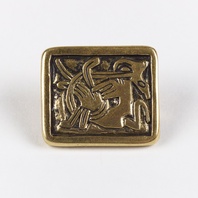
Viking Objects
Reproduction Square Mammen Brooch
This reproduction brooch is based on a small number of Mammen-style brooches found in England. Three rectangular brooches of this type are known from Linwood, Lincolnshire, West Stow Heath, Suffolk, and Bergh Apton, Norfolk, with further examples found in Cambridgeshire and East Anglia in 2015 and 2016. It is a type which has Carolingian-inspired shapes and Scandinavian decoration, which seem to have been produced in the Danelaw, and was an accessory for women who wore Scandinavian dress. Scandinavian brooches came in a variety of sizes and shapes which included disc, trefoil, lozenge, equal-armed, and oval shapes. The different brooch types served a variety of functions in Scandinavian female dress with oval brooches typically being used as shoulder clasps for apron-type dresses and the rest being used to secure an outer garment to an inner shift. Anglo-Saxon brooches do not match this diversity of form with large disc brooches being typical of ninth century dress styles with smaller ones becoming more popular in the later ninth and tenth centuries. However, since disc brooches were used by both Anglo-Saxon and Scandinavian women they are distinguished by their morphology. Scandinavian brooches were typically domed with a hollow back while Anglo-Saxon brooches were usually flat. Moreover, Anglo-Saxon brooches were worn singly without accompanying accessories.
Read More

Viking Names
Bigby
Bigby, in the Yarborough Wapentake of Lincolnshire, probably comes form the Old Norse male personal name Bekki and the Old Norse element by ‘farm, settlement’.
Read More
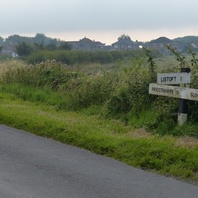
Viking Names
Sloothby
Sloothby, in the Calcewath Wapentake of Lincolnshire, is a complicated name. There are multiple possibilities for the first element of the place-name. The second element is the Old Norse element by ‘a farmstead, a village’. One suggestion is that the first element is the Old Norse byname Slóði ‘the lazy one’; however, this name is not found independently in Lincolnshire and is uncommon in Scandinavia. Another alternative is that the first element could be slóði used as a river-name, referring to a slow-moving sluggish stream. Sloothby is in the fens and a stream runs by. Furthermore, the first element could be the Old Norse element slóð ‘a track, trail’, perhaps referring to a track through the fens. Sloothby is a joint parish with Willoughby.
Read More
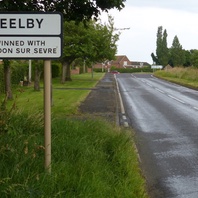
Viking Names
Keelby
Keelby, in the Yarborough Wapentake of Lincolnshire, is a Old Norse compound coming from kjǫlr ‘a keel, a ridge (of hills)’ and by ‘farmstead, village’. The village is situated on a rising piece of ground between 15 and 20 metre contours (one small patch above 20 metres). This forms a distinct elongated ‘ridge’ running south-east-north-west.
Read More

Viking Names
Tumby
Tumby, in the Gartree Wapentake of Lincolnshire, is a difficult name. The first element may be the Old Norse male personal name Tumi, a name which occurs in several Swedish and Danish runic inscriptions. Alternatively the first element could be Old Norse tún ‘an enclosure, a farmstead’. The second element is bý ‘a farmstead, a village’.
Read More
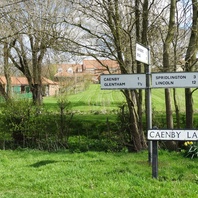
Viking Names
Caenby
Caenby, in the Aslacoe Wapentake of Lincolnshire. likely comes from the otherwise unrecorded Old Norse male byname Kafni (probably originally a byname) and the Old Norse element bý ‘a farmstead, a village’,
Read More
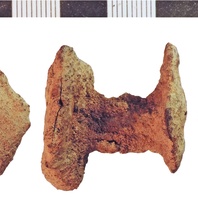
Viking Objects
Clench Nail (NLM-2FC690)
Clench nails were used in clinker-style ship-building from the 7th century to the 15th and also for domestic purposes, in which clench nails might appear where ship timber has been reused. Clinker ship-building involved building the ship’s hull first out of layered planks attached to the keel and held together using clench nails. Clinker-built boats and ships are particularly associated with the Vikings.
Read More
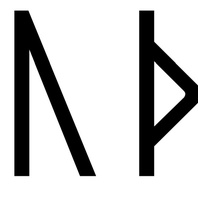
Viking Names
Gyda
Gyða appears early in Norway and is frequent there but it is not as common in Iceland. It appears in two Danish runic inscriptions and is common in other Danish sources. The name also appears in a few Swedish runic inscriptions and is found in later Swedish sources. Gyða is also attested in medieval documents from Lincolnshire and Domesday Book for Yorkshire. The name is a pet form of Gyríðr and it has been suggested that it was borrowed from England because several of the oldest carriers of the name appear to be of mixed Nordic and English origin.
Read More

Viking Names
Snarford
Snarford, in the Lawress Wapentake of Lincolnshire, is an Anglo-Scandinavian hybrid from the genitive singular form of the Old Norse male personal name Snǫrtr, i.e. Snartar, and Old English ford ‘a ford’. The ford crossed Barlings Eau and Snarford may have been situated on an ancient line of communication between Lincoln and the Wolds.
Read More

Viking Names
Snort
Snǫrtr was originally a byname similar in meaning to Norwegian snerting ‘quick fellow’. It is fairly common as a personal name in Iceland. The genitive singular form of the name, Snartar, is the first element in Snarford, Lincolnshire.
Read More
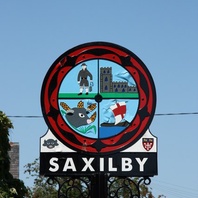
Viking Names
Saxilby
Saxilby, in the Lawress Wapentake of Lincolnshire, comes from the Old Norse male personal name Saksulfr and Old Norse by ‘a farmstead, a village’. It is a joint parish with Ingleby.
